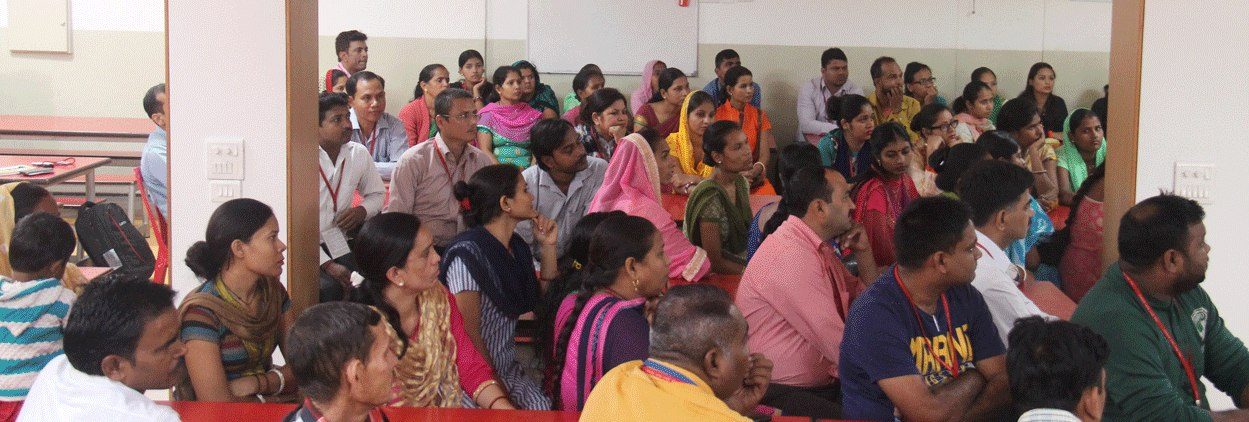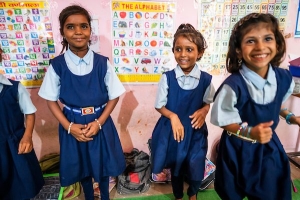Puja Bisht was in a rush. It was time for her to ferry her sons back home from school, just two blocks away. She locked up her one-room house in Meethapur, a low-income area that lies west of the Indian capital of Delhi, and began carefully negotiating the waterlogged streets to get to the school, while sneaking frequent peeks at her phone for the time.
Puja had moved to the city with her husband and two sons a few years back from her village in the hills of Garhwal. As a stay-at-home mother, it was her responsibility to look after the education of her sons, as her husband – a car mechanic – was unable to take out time to teach the children.
“Their father tries to be involved but he is away most of the day at work, and when he comes back in the evening, he is too tired to teach them,” she says.
Puja spends at least two to three hours a day teaching her sons, who study in grade 3 and grade 1, using traditional methods as well as innovative methods that she has learned from a local educational nonprofit. And she is the person they turn to when they need answers to their questions.
“They come to me with all their questions, whether it is about life or a math problem,” Puja laughs. “Even if I ask them to go and ask their father, they insist on asking me.”
This trust among children is what makes their mothers a hidden resource for India, which has been grappling with a spiralling learning crisis. And the good news is that education nonprofits have begun to harness this resource.
“In the early years, children learn from their environment, so the mother’s role is absolutely critical. We teach them how to talk to their children, what to share with them and what not, how to encourage children to ask questions, and inculcate a basic sense of health and hygiene,” says K. Vaijayanti, Director of Research, Resource and Evaluation, Akshara Foundation.
In 2018, the Annual Status of Education Report (ASER) found that after five years of schooling, at the age of 10-11 years, just over half (50.3%) of students in India could read a class 2-level text, meant for 7- to 8-year-olds. This is a drop from 56.2% in 2008. The percentage of class 5 children who could do math divisions in 2018 also dropped to 27.8% from 37% in 2008.
As primary caregivers, Indian mothers can help reverse this learning deficiency.
“We are teaching our children throughout the day through casual conversation,” Ruchi, mother to a 4-year-old, points out. “I teach my son at last ten things from morning till evening,” she adds.
Ruchi is a relationship manager with Saarthi, a nonprofit that has been working to improve the role of parents in the education of their children aged between 3 and 7 years. She lives in the same neighborhood as Puja, who is also a Saarthi mother.
“The mothers always say, ‘How can we do this? We are not educated.’ We always tell them, you run a household, you can measure how much to cook for how many people – you already know how to do it,” notes Ankit Arora, founder of Saarthi.
To ensure continuous involvement of mothers in their children’s learning, Saarthi not only gives the parents workbooks for the children to practice with, but also places weekly calls to help them work through the books.
“I want my child to grow, but there were no new ideas. The books are the same and boring. Here, we have learnt how to keep teaching the kids while doing household chores,” Puja says.

Another education nonprofit that has been working to improve learning outcomes among children aged 2-6 years is Dost Education. They have been reaching out to mothers from low-income groups through pre-recorded audio curriculum over the phone, or phonecasts.
“Hi – from your friends at Dost!” is how the phonecasts begin, striking an immediate note of friendliness and accessibility with the parents. The 24-week programme, called Dost ki Pathshala (Friend’s School), involves four calls a week aimed at improving a child’s learning outcomes in preschool through to class 1. From 300 users in 2017 to over 10,000 in 2018, the program has been a huge success among underprivileged mothers. It has made them a patient and willing participant in their children’s learning.
“More than my child, I have seen a change in myself. Before, I used to yell at my child to get something done. Now, I find myself explaining things,” a mother was quoted saying in a Dost newsletter.
India has, according to Census 2011 data, 164.48 million children of 0-6 years of age. In 2009, the Indian Parliament made education free and compulsory for children aged between 6-14. The government has also recognized the importance of early childcare and education in its recently released draft National Education policy, stating that the early years (ages 3 to 8) should be considered a “foundational stage” and must be a continuum. However, much of the outcome of these policies will depend on whether mothers remain mere caretakers or are able to become equal stakeholders in their children’s early and future education.
“Education is already an aspiration in rural India and among the urban poor. If we can enhance the mother’s role along with her economic empowerment, it will bring about a great shift in the learning outcomes of children,” says Akshara Foundation’s K. Vaijayanti.
These nonprofits are working on a simple belief – a child learns best from the mother because they spend the most time with her. Which is why, they have been trying to highlight and enhance the role of mothers in the preschool stage.
“We have already seen this work with urban and middle-class mothers, whose investment in their children’s education has really paid off,” explains Vaijayanti. “We need encourage the same involvement across the board.”
Meanwhile, back in Meethapur, Puja’s children are bubbling with excitement. They cannot wait for the next phone call from Saarthi, when they will sit down together with their mother to complete their worksheets for the week.
“It was daunting for me in the beginning, but now I enjoy the exercises as much as they do and look forward to this time of learning together,” Puja says with a smile.
A mother is often called a child’s best friend. She is a safe space, a refuge. And if she can be trained to be their first “guru” or teacher, the outcomes can only dazzle.
Names of some individuals have been changed to protect their identity



